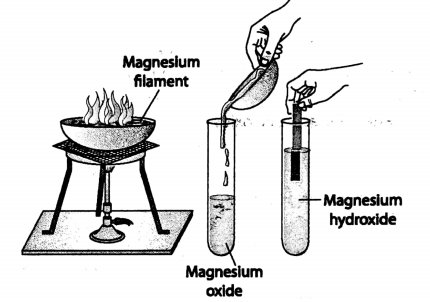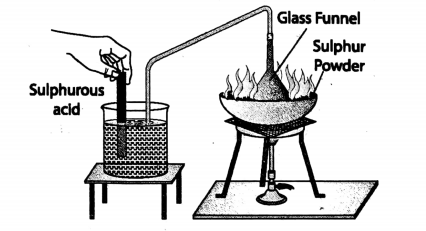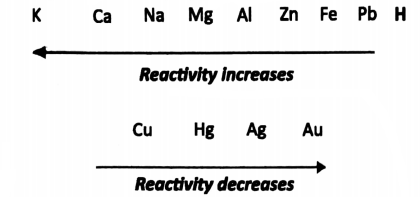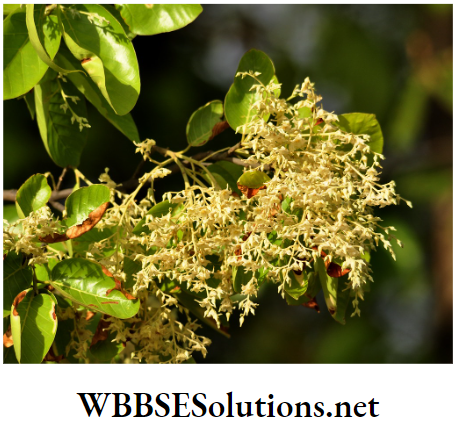WBBSE Chapter 11 Plant Kingdom And The Environment Around Us Long Answer Questions
Question 1. Describe the general uses of Bamboo. What are the components of Tabashir?
Answer:
Bamboo:
Bamboo is a tribe of flowering perennial evergreen plants in the grass family with solid nodes and hollow internodes. In bamboo, the vascular bundles in the cross section are scattered throughout the stem instead of in a cylindrical arrangement.
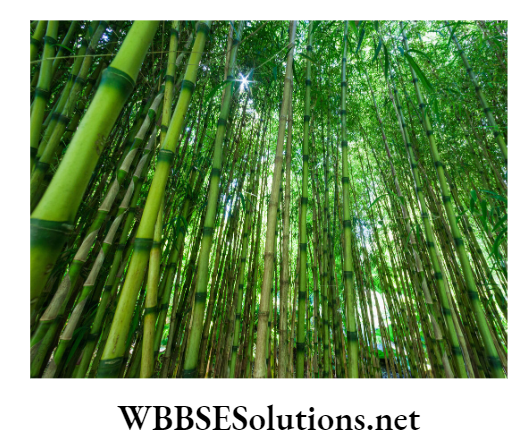
Bamboos are some of the fastest-growing plants in the world, due to a unique rhizome-dependent system. Bamboos are of notable economic and cultural significance in South Asia, Southeast Asia, and East Asia, being used for building materials, as a food source, and as a versatile raw product.
Read And Learn More WBBSE Solutions For Class 8 School Science Long Answer Type Questions

Bamboo has a higher compressive strength than wood, brick, or concrete and a tensile strength that rivals steel. The word bamboo comes from the Kannada term bambu, which was introduced to English.
Ecology: Bamboo is one of the fastest-growing plants on Earth, with reported growth rates of 250 cm (98 in) in 24 hours.
However, the growth rate is dependent on local soil and climatic conditions, as well as species and a more typical growth rate for many commonly cultivated bamboos in temperate climates is in the range of 3—10 centimeters (1.2—3.9 in) per day during the growing period.
Primarily growing in regions of warmer climates during the late Cretaceous period, vast fields existed in what is now Asia.
Some of the largest timber bamboos can grow over 30 m (98 ft) tall and be as large as 1520 cm (5.9-7.9 in) in diameter.
However, the size range for mature bamboo is species-dependent, with the smallest bamboo reaching only several inches high at maturity.
Unlike all trees, individual bamboo stems, or culms, emerge from the ground at their full diameter and grow to their full height in a single growing season of three to four months.
Over the next 2-5 years (depending on species), the fungus begins to form on the outside of the culm, which eventually penetrates and overcomes the culm.
Around 5-8 years later (species and climate dependent), the fungal growths cause the culm to collapse and decay.
Mass flowering: Most bamboo species flower infrequently. In fact, many bamboos only flower at intervals as long as 65 or 120 years.
These taxa exhibit mass flowering (or gregarious flowering), with all plants in a particular cohort flowering over a several-year period.
The lack of environmental impact on the time of flowering indicates the presence of some sort of “alarm clock” in each cell of the plant which signals the diversion of all energy to flower production and the cessation of vegetative growth.
This mechanism, as well as the evolutionary cause behind it, is still largely a mystery.
Mass fruiting also has direct economic and ecological consequences, however. The huge increase in available fruit in the forests often causes a boom in rodent populations, leading to increases in disease and famine in nearby human populations.
WBBSE Class 8 Plant Kingdom long answer questions
For example, devastating consequences occur when the Melocanna bambusoides population flowers and fruits once every 30-35 years around the Bay of Bengal.
The death of the bamboo plants following their fruiting means the local people lose their building material, and the large increase in bamboo fruit leads to a rapid increase in rodent populations.
As the number of rodents increases, they consume all available food, including grain fields and stored food, sometimes leading to famine.
These rats can also carry dangerous diseases, such as typhus, typhoid, and bubonic plague, which can reach epidemic proportions as the rodents increase in number.
In any case, flowering produces masses of seeds, typically suspended from the ends of the branches. These seeds will give rise to a new generation of plants that may be identical in appearance to those that preceded the flowering,
or they may produce new cultivars with different characteristics, such as the presence or absence of striping or other changes in the coloration of the culms.

General Uses for Bamboo: Bamboo has been used for many applications, from a food source to a building material.
1. Decorations: From picture frames to room dividing screens, bamboo can make some elegant and exotic decorations for the home,
2. Building materials: More and more furniture, flooring, and even homes are being built with bamboo. Bamboo is a popular building material in South and East Asia and in South Pacific Islands.
Bamboo stems have also been extensively used to construct numerous footbridges over canals and streams.
3. Fabrics and clothing: a fabulous trend right now is bamboo fibers being used in fabrics and clothing since the diameter of bamboo fibers measures less than 3 mm.
Bedding made of bamboo fibers is as soft as or softer than most cotton beddings and drapes with the look of silk without the expense.
Food items and Cooking:
The young stem, basal part of the stem, and leaves of bamboo are chief food items of the Giant panda of China, the Red panda of Nepal and India, and the Lemur of Madagascar. Gorillas primarily eat bamboo. It is also the food of elephants and chimpanzees.
After extracting toxic substances, various delicious dishes have been prepared in different Asian countries by using the soft young stems of bamboo.
Certain beverages are also prepared from these young stems. A type of insect grows at the base of bamboo plants growing in the Yunan provinces of China and in countries like Laos, Myanmar, and Thailand. They feed on the young stems of bamboo. The local people use the larva of these insects as their food.
Cooking with bamboo is nothing new in Asian culture. Hollow stems of bamboo have been used in different places in South Africa for warming soups and as pots for cooking rice.
Bamboo-made utensils are also used extensively for cooking purposes. Bamboo cutting boards are notoriously good for not dulling blades or knives as quickly, while bamboo utensils like wooden spoons are excellent for not scratching the bottoms of expensive nonstick cookware.
Medicine: Tabashir, a medicine for asthma, colds and cough, and other infectious diseases, is made from silicon dioxide and silicic acid derived from the internodes of a bamboo species called Bambusa arundinacea.
Agriculture: Bamboo started out as a natural plant in most places, but has become a large part of agriculture. From being the main crop of a farm to be harvested for other uses, or as the channel linings for irrigation systems, bamboo fits naturally into agriculture.
Weapons: While this is rarely seen anymore, bamboo was once used to make many different types of weapons. From blow guns to archery bows and arrows, bamboo was used to make light but strong weapons for many centuries.
Instruments: Hollow tubes make excellent instruments, whether it is a flute or a drum, and bamboo is one of the best bases for instruments.
Need and strategies for conservation: With the increasing population pressure, natural stands of bamboo are being indiscriminately cut for fuel wood, and furniture.
The common practice of ‘jhum’ (a form of shifting cultivation) cultivation in the northeastern states has resulted in the genetic erosion of several bamboo species; overexploitation of some species for fuel wood and for the cottage industry has endangered others.
Large areas where bamboo occurs have been declared as National Bamboo Reserve areas and provenances in the natural habitats are being maintained.
Considering the limitation in seed supply, vegetative methods for ex-situ conservation and tissue culture work have been started in Asian countries.
Long answer type questions on biodiversity for Class 8
Question 2. What is water hyacinth? Why are they considered invasive species?
Answer:
Invasive species: Water hyacinth has been widely introduced in North America, Asia, Australia, Africa, and New Zealand. In many areas, it has become an important and pernicious invasive species.
In New Zealand, it is listed on the National Pest Plant Accord which prevents it from being propagated, distributed, or sold. In large water areas such as Louisiana, the Kerala Backwaters in India, Tonle Sap in Cambodia, and Lake Victoria it has become a serious pest.
When not controlled, water hyacinth will cover lakes and ponds entirely; this dramatically impacts water flow, blocks sunlight from reaching native aquatic plants, and starves the water of oxygen, often killing fish (or turtles).
The plants also create a prime habitat for mosquitos, the classic vectors of disease, and a species of snail known to host a parasitic flatworm that causes schistosomiasis (snail fever).
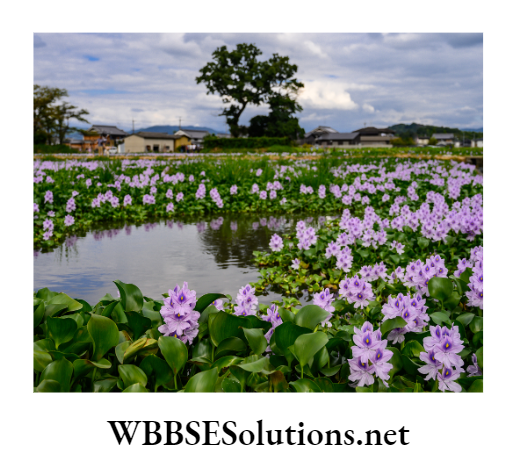
Uses
Phytoremediation, wastewater treatment: The roots of Eichhornia crassipes naturally absorb pollutants, including lead, mercury, and strontium-90, as well as some organic compounds believed to be carcinogenic, in concentrations 10,000 times that in the surrounding water Water hyacinths can be cultivated for wastewater treatment.
Water hyacinth is reported for its efficiency to remove about 60-80 % nitrogen and about 69% of potassium from water. The roots of water hyacinth were found to remove particulate matter and nitrogen in a natural shallow eutrophicated wetland.
Polluted water from gold mine areas can be treated by vegetables in Taiwan. Javanese sometimes cook and eat the green parts and inflorescence.
Medicinal use: In Kedah (Java), the flowers are used for medicating the skin of horses. The species is a “tonic.”
In the Philippines, Thailand, and Vietnam stems of water hyacinth are used for the purpose of embroidery and as fiber for the garment industry.
- The dry stem is used to manufacture baskets and furniture. Fibers of the plant are also used to make paper.
- Water hyacinth is a good source of biogas as it contains appreciable amounts of nitrogen.
- Since water hyacinth contains a high amount of protein and nitrogen, it is also used as fodder. But excess use can lead to toxicity.
Control: Water hyacinth control is difficult. The most effective method of control depends on prevention. Make sure to control the nutrient levels in your pond or lake to prevent rapid and explosive growth.
Do not introduce water hyacinths to new ponds unless you are willing to monitor them and take action if their growth gets out of control.
It is advised that you only introduce water hyacinth to your own personal ornamental water gardens. Introducing it into natural water bodies invites trouble.
When harvesting or otherwise removing water hyacinth, do not discard it in the natural waterway, instead put it into a compost pile.
Question 3. What are the uses of Sal?
Answer:
Uses of sal
Wood: Sal is one of the most important sources of hardwood timber in India, with hard, coarse-grained wood that is light in color when freshly cut, but becomes dark brown with exposure.
The wood is resinous and durable, and is sought-after for construction, although not well suited to planning and polishing.
The wood is especially suitable for constructing frames for doors and windows, floors of boats, jetties of ships,s, and footbridges over streams.
Leaves: The dry leaves of sal are a major source for the production of leaf plates called paravail and leaf bowls in northern and eastern India.
The leaves are also used fresh to serve ready-made paan (betelnut preparations) and small snacks such as boiled black grams, golgappa, etc.
The used leaves/plates are readily eaten by goats and cattle that roam the streets freely. The tree has therefore protected northern India from a flood of styrofoam and plastic plates that would have caused tremendous pollution. The leaves are also used in rural areas as fuel.
Resin: Sal tree resin is used as an astringent in Ayurvedic medicine, and to make spirit and varnish.
Seeds: Sal seeds and fruit are a source of lamp oil and vegetable fat. Shorea robusta seed oil is extracted from the seeds and used as cooking oil after refining.
Tannin: Tannin derived from sal bark finds application in the leather industry.
Sal tree is worshipped among the Buddhists and Hindus in India. It is mentioned in many scriptures that the Buddha was born and died under the Sal tree.
The Sal tree has special significance in the festivals and marriages of Adivasi. A pole of the Sal tree is considered very important and unless the bridegroom sits on the altar made of the tree of Sal, the marriage has no meaning.
It also holds great value in the lives of the indigenous populace of the Chotanagpur plateau. It is the main attraction of the festival of Sarhul, which means the Sal Blossoms Festival. The whole festival revolves around the Sal tree.
Question 4. What are spices? How do they differ from herbs? Give a few examples of spices.
Answer:
Spices:
A spice is a dried seed, fruit, root, bark, or vegetable substance primarily used for flavoring, coloring, or preserving food.
Many spices have antimicrobial properties. This may explain why spices are more commonly used in warmer climates, which have a more infectious disease, and why the use of spices is prominent in meat, which is particularly susceptible to spoiling.
A spice may have other uses, including medicinal, religious ritual, cosmetics or perfume production, or as a vegetable. For example, turmeric roots are consumed as a vegetable, and garlic as an antibiotic.
The spice trade developed throughout South Asia and the Middle East in around 2000 BCE with cinnamon and pepper, and in East Asia with herbs and pepper.
Indian spices include a variety of spices grown across the Indian subcontinent (a sub-region of South Asia). With different climates in different parts of the country, India produces a variety of spices, many of which are native to the Subcontinent, while others were imported from similar climates and have since been cultivated locally for centuries.
We often use the words herb and spice interchangeably. Herbs and spices are obtained from plants. Herbs and spices are used primarily for adding flavor and aroma to food.
And both are best used fresh but can be saved by drying. While there are similarities, there also are subtle differences between herbs and spices.
Herbs are obtained from the leaves of herbaceous (non-woody) plants. They are used for savory purposes in cooking and some have medicinal value. Herbs often are used in larger amounts than spices.
Spices are obtained from roots, flowers, fruits, seeds, or bark. Spices are native to warm tropical climates and can be woody or herbaceous plants.
Spices often are more potent and stronger flavored than herbs; as a result, they typically are used in smaller amounts. Some spices are used not only to add taste but also as a preservative.
Examples of Spices:
- Cinnamon – the bark of the cinnamon tree
- Ginger-root
- Cloves – flower bud
- Saffron – stigma (female reproductive part) of Saffron crocus
- Nutmeg – seed
- Vanilla – undeveloped fruit of an orchid
- Cumin – seed
Black pepper: Black pepper (Piper nigrum) is a flowering vine cultivated for its fruit, which is usually dried and used as a spice and seasoning.
The fruit, known as a peppercorn when dried, is approximately 5 millimeters (0.20 in) in diameter, dark red when fully mature, and, like all drupes, contains a single seed.
Peppercorns, and the ground pepper derived from them, may be described simply as pepper, or more precisely as black pepper (cooked and dried unripe fruit), green pepper (dried unripe fruit), and white pepper (ripe fruit seeds).
Black pepper is native to south India and is extensively cultivated there and elsewhere in tropical regions. Currently, Vietnam is the world’s largest producer and exporter of pepper.
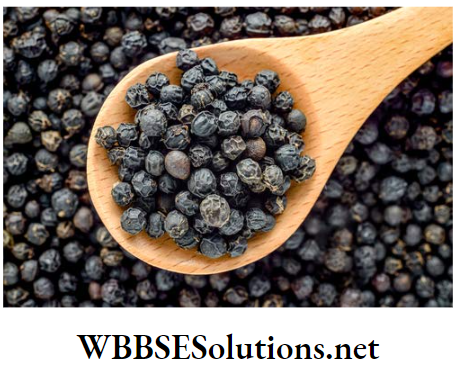
Uses:
Dried ground pepper has been used since antiquity for both its flavor and as a traditional medicine. Black pepper is the world’s most traded spice.
It is one of the most common spices added to European cuisine and its descendants. The spiciness of black pepper is due to the chemical piperine. It is ubiquitous in the modern world as a seasoning and is often paired with salt.
Apart from spicy value, black pepper is also used as a preservative for meat and other perishable food items.
The health benefits of black pepper include relief from respiratory disorders, coughs, the common cold, constipation, indigestion, anemia, impotency, muscular strains, dental disease, pyorrhea, diarrhea, and heart disease.
Black pepper (Piper nigrum)stimulates the taste buds in such a way that an alert is sent to the stomach to increase hydrochloric acid secretion, thereby improving digestion.
Hydrochloric acid is necessary for the digestion of proteins and other food components in the stomach. Black pepper has long been recognized as a carminative,
(a substance that helps prevent the formation of intestinal gas), a property likely due to its beneficial effect of stimulating hydrochloric acid production.
In addition, black pepper has diaphoretic (promotes sweating), and diuretic (promotes urination) properties.
Cinnamon: Cinnamon is a spice obtained from the inner bark of several trees from the genus Cinnamomum that is used in both sweet and savory foods.
The inner bark of a tropical evergreen tree, harvested during the rainy season when pliable and then dried into curls sold as sticks or ground into a powder. With its warm, sweet flavor, cinnamon is one of the biggest workhorses on the spice shelf.
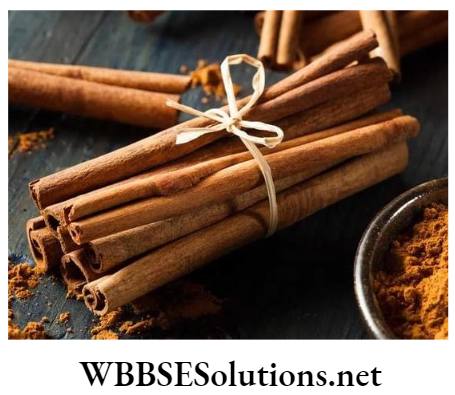
Conservation of endangered animals long answers for Class 8
Uses:
Cinnamon bark is widely used as a spice. It is principally employed in cookery as a condiment and flavoring material.
It is used in the preparation of chocolate, especially in Mexico, which is the main importer of cinnamon.
It is also used in many dessert recipes, such as apple pie, doughnuts, and cinnamon buns as well as spicy candies, coffee, tea, hot cocoa, and liqueurs.
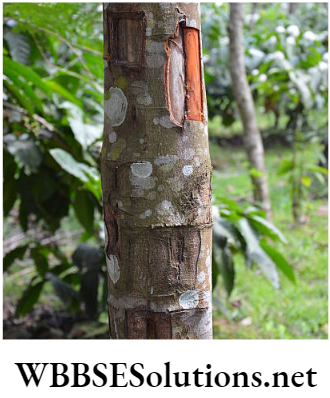
In the Middle East, cinnamon is often used in savory dishes of chicken and lamb. In the United States, cinnamon and sugar are often used to flavor cereals, and bread-based dishes, such as toast, and fruits, especially apples; a cinnamon-sugar mixture is even sold separately for such purposes.
It is also used in Turkish cuisine for both sweet and savory dishes. It can also be used in pickling. Cinnamon powder has long been an important spice in enhancing the flavor of Persian cuisine, used in a variety of thick soups, drinks, and sweets.
It has been prized for its medicinal properties for thousands of years. Besides using it in cooking, cinnamon is also thought to have health benefits.
The naturally sweet taste may help some people reduce their sugar intake. In Ayurveda, cinnamon is used as a remedy for diabetes, indigestion, and colds. Volatile oil prepared from cinnamon provides relief for arthritic pain.
Turmeric: Turmeric (Curcuma longa) is a rhizomatous herbaceous perennial plant of the ginger family. It is native to southwest India and needs temperatures between 20 and 30°C (68 and 86’F) and a considerable amount of annual rainfall to thrive.
Plants are gathered annually for their rhizomes and propagated from some of those rhizomes in the following season. India, a significant producer of turmeric, has regional names based on language and country.
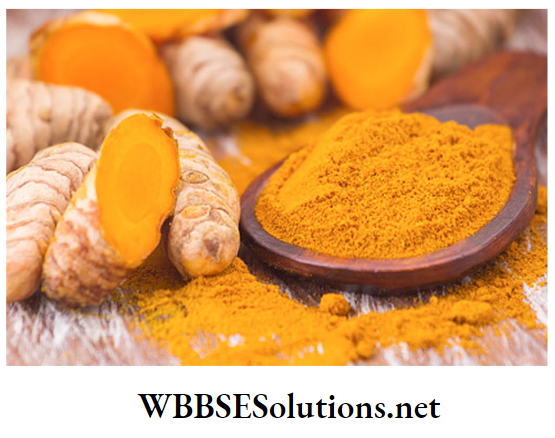
When not used fresh, the rhizomes are boiled for about 30-45 minutes and then dried in hot ovens, after which they are ground into a deep-orange-yellow powder commonly used as a spice in Indian cuisine and curries, for dyeing, and to impart color to mustard condiments.
One active ingredient is curcumin, which has a distinctly earthy, slightly bitter, slightly hot peppery flavor and a mustardy smell.
Turmeric plants reach up to 1 m tall. Highly branched, yellow to orange, cylindrical, aromatic rhizomes are found. The leaves are alternate and arranged in two rows.
They are divided into leaf sheath, petiole, and leaf blade. From the leaf sheaths, a false stem is formed. The petiole is 50 to 115 cm long.
The simple leaf blades are usually 76 to 115 cm long and rarely up to 230 cm. They have a width of 38 to 45 cm and are oblong to an elliptic narrowing at the tip.
Uses:
We probably know turmeric as the main spice in curry. It has a warm, bitter taste and is frequently used to flavor or color curry powders, mustards, butter, and cheeses.
But the root of turmeric is also used widely to make medicine. In food and manufacturing, the essential oil of turmeric is used in perfumes, and its resin is used as a flavor and color component in foods.
It has been known as poor man’s saffron because it offers a less expensive alternative yellow coloring. Turmeric is mostly used in flavored milk drinks, cultured milk, and desserts to obtain lemon and banana colors in dairy.
ln turmeric, curcumin is the primary pigment and is generally used in various food industries as a food color. Turmeric is added at higher levels to sausages, pickles, relishes, sauces, dry mixes, and fish due to its original usage as a spice.
Due to the presence of a compound called curcumin in turmeric, it has the ability to kill microbes. Turmeric keeps the liver healthy. It is effective in controlling anemia due to the presence of a good amount of iron in it. Turmeric also controls blood cholesterol levels.
Turmeric is used for arthritis, heartburn (dyspepsia), stomach pain, diarrhea, intestinal gas, stomach bloating, loss of appetite, jaundice, liver problems, and gallbladder disorders.
It is also used for headaches, bronchitis, colds, lung infections, fibromyalgia, leprosy, fever, menstrual problems, and cancer. Other uses include depression. Alzheimer’s disease, water retention, worms, and kidney problems.
Some people apply turmeric to the skin for pain, ringworm, bruising, leech bites, eye infections, inflammatory skin conditions, soreness inside of the mouth, and infected wounds.
Women in India apply turmeric before taking bath as its antibacterial property protects the skin from infects and protects it from harsh sunlight.
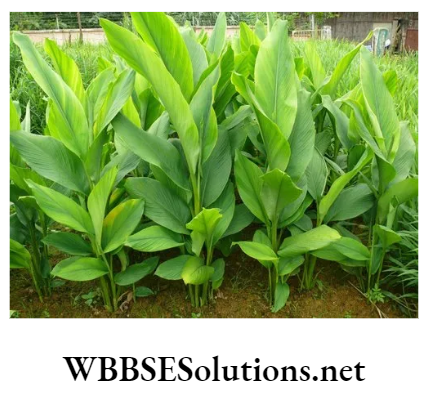
Key long answer questions about plant kingdom for Class 8
Cardamom: Cardamom is a spice made from the seeds of several plants in the genera Elettaria and Amomum. Both genera are native to India, Pakistan, Nepal, and Bhutan; they are recognized by their small seed pods, triangular in cross-section and spindle-shaped, with a thin, papery outer shell and small black seeds.
There are two main types of cardamom:
True or green cardamom (or, when bleached, white cardamom comes from the species Elettaria cardamomum and is distributed from India to Malaysia.
Black cardamom, also known as brown, greater, longer, or Nepal cardamom, comes from two species, Amomumcostatum and Amomum subulatum, which are distributed mainly in Asia and Australia.
Uses: Both forms of cardamom are used as flavorings and cooking spices in both food and drink and as medicine.
Besides being used as flavoring and spice in foods, cardamom-flavored tea, also flavored with cinnamon, is consumed as a hot beverage in Bangladesh, India, and Pakistan.
Cardamom has a strong, unique taste, with an intensely aromatic, resinous fragrance. Black cardamom has a distinctly smokey, though not bitter, aroma, with a coolness some consider similar to mint.
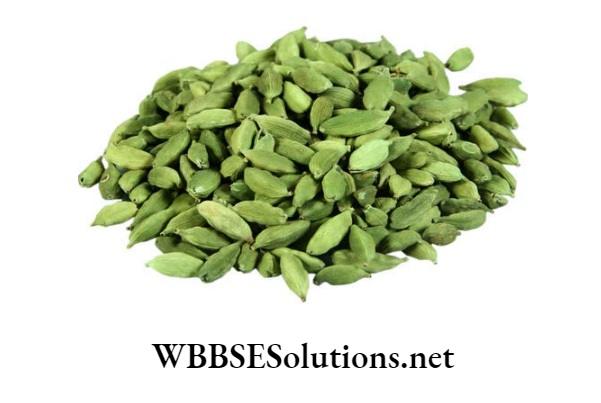
Green cardamom is one of the most expensive spices by weight but little is needed to impart flavor. It is best stored in pod form because once the seeds are exposed or ground, they quickly lose their flavor.
It is a common ingredient in Indian cooking and is often used in baking in Nordic countries, in particular Sweden and Finland.
In the Middle East, green cardamom powder is used as a spice for sweet dishes, as well as a traditional flavoring in coffee and tea. Cardamom is used to a wide extent in savory dishes.
‘In Asia, both types of cardamom are widely used in both sweet and savory dishes, particularly in the south. Both are frequent components in spice mixes, such as Indian and Nepali masalas and Thai curry pastes.
Green cardamom is often used in traditional Indian sweets and in masala chai (spiced tea). Both are also often used as a garnish in basmati rice and other dishes. Individual seeds are sometimes chewed and used in much the same way as chewing gum.
Green cardamom is broadly used in South Asia to treat infections in teeth and gums, to prevent and treat throat troubles, congestion of the lungs and pulmonary tuberculosis, inflammation of eyelids, and digestive disorders.
It also is used to break up kidney and gall stones and was reportedly used as an antidote for both snake and scorpion venoms.
Amomum is used as a spice and as an ingredient in traditional medicine systems of the traditional Chinese medicine in China, in Ayurveda in India, Pakistan, Japan, Korea, Nepal, and Vietnam.
Among other species, varieties, and cultivars, Amomum villosum cultivated in China, Laos, and Vietnam is used in traditional Chinese medicine to treat stomach problems, constipation, dysentery, and other digestion problems.
Garam masala, which literally means hot (garam) spice (masala), is a popular spice blend used throughout India and neighboring countries too.
It is a powder made of several types of spices and is added in small quantities at the end of the cooking process, or along with the tempering.
A typical Indian version of garam masala contains- black and white peppercorns, cloves, cinnamon or cassia bark, nutmeg and mace, black and green cardamom pods, Bay leaf, caraway, etc. Garam masala can be used alone or along with other seasonings and spice powders.
Ginger: Ginger [Zingiber officinale) is a flowering plant whose rhizome, ginger root, or simply ginger, is widely used as a spice or a medicine.
It is a herbaceous perennial that grows annual stems about a meter tall bearing narrow green leaves and yellow flowers.
Ginger is indigenous to southern China and was spread eventually to other parts of Asia and subsequently to West Africa and the Caribbean. India is now the largest producer of ginger.
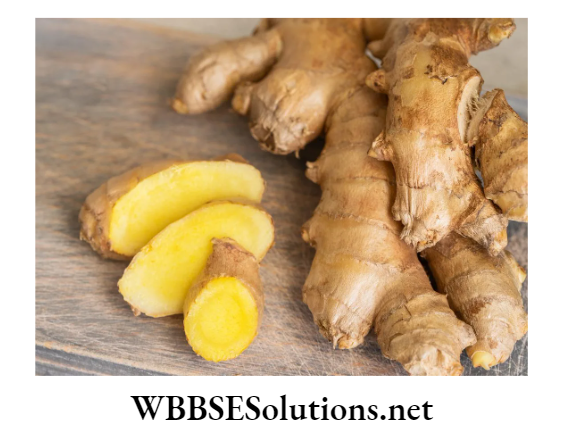
WBBSE Chapter 10 exercises long answer solutions
Uses:
Ginger produces a hot, fragrant kitchen spice, vinegar, or sherry as a snack or cooked as young ginger rhizomes are juicy and fleshy with ingredients in many dishes.
They can be steen-ea very mild taste. They are often pickled in boiling water to make ginger tea, to which honey is often added; sliced orange or lemon fruit may be added.
Ginger can be made into candy or ginger wine. Mature ginger rhizomes are fibrous and nearly dry. The juice from ginger roots is often used as a spice.
In Indian recipes and is a common ingredient in Chinese, Korean, Japanese, Vietnamese, and many South Asian cuisines for flavoring dishes such as seafood, meat, and vegetarian dishes. The rhizome (underground stem) is used as a spice and also as a medicine.
It can be used fresh, dried, and powdered, or as a juice or oil. Ginger is commonly used to treat various types of stomach problems, including motion sickness, morning sickness, colic, upset stomach, gas, diarrhea, nausea caused by cancer treatment, nausea, and vomiting after surgery, as well as loss of appetite.
Other uses include pain relief from arthritis or muscle soreness, upper respiratory tract infections, cough, and bronchitis.
Ginger is also sometimes used for chest pain, low back pain, and stomach pain. Some people pour fresh juice on their skin to treat burns. The oil made from ginger is sometimes applied to the skin to relieve pain.
Garlic: Allium sativum, commonly known as garlic, is a species in the onion genus. With a history of human use of over 7,000 years, garlic is native to central Asia and has long been a staple in the Mediterranean region, as well as a frequent seasoning in Asia, Africa, and Europe.
It was known to Ancient Egyptians and has been used for both culinary and medicinal purposes. Allium sativum is a bulbous plant.
It grows up to 1.2 m (4 ft) in height. It produces hermaphrodite flowers. Pollination occurs by bees and other insects.
The garlic plant’s bulb is the most commonly used part of the plant.
With the exception of the single clove types, garlic bulbs are normally divided into numerous fleshy sections called cloves.
Garlic cloves are used for consumption (raw or cooked) or for medicinal purposes. They have a characteristic pungent, spicy flavor that mellows and sweetens considerably with cooking.
Other parts of the garlic plant are also edible. The leaves and flowers (bulbils) on the head (spathe) are sometimes eaten.
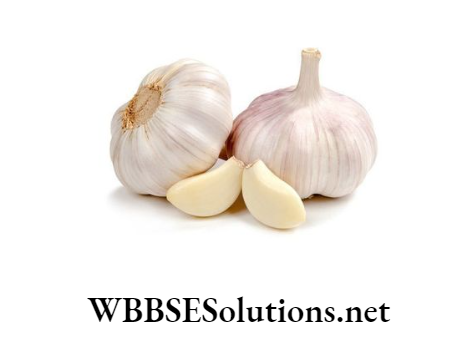
Uses:
Garlic is widely used around the world for its pungent flavor as a seasoning or condiment. Garlic may be applied to different kinds of bread, usually in a medium of butter or oil, to create a variety of classic dishes, such as garlic bread, garlic toast, etc.
Garlic is a herb. It is best known as a flavoring for food. But over the years, garlic has been used as a medicine to prevent or treat a wide range of diseases and conditions.
Fresh cloves or supplements made from the clove are used for medicine. Garlic contains a compound called Allicin. It has antimicrobial properties.
Garlic is used for many conditions related to the heart and blood system. These conditions include high blood pressure, high cholesterol, coronary heart disease, heart attack, and hardening of the arteries (atherosclerosis).
Some of these uses are supported by science. Garlic actually may be effective in slowing the development of atherosclerosis and seems to be able to modestly reduce blood pressure.
Some people use garlic to prevent colon cancer, rectal cancer, stomach cancer, breast cancer, prostate cancer, and lung cancer. It is also used to treat prostate cancer and bladder cancer.
Garlic has been tried for treating an enlarged prostate (benign prostatic hyperplasia; BPH), diabetes, osteoarthritis, hayfever (allergic rhinitis), traveler’s diarrhea, high blood pressure late in pregnancy (pre-eclampsia), cold, and flu.
It is also used for building the immune system, preventing tick bites, and preventing and treating bacterial and fungal infections.
Other uses include the treatment of fever, coughs, headache, stomach ache, sinus congestion, gout, rheumatism, hemorrhoids, asthma, bronchitis, shortness of breath, low blood pressure, Jow blood sugar, high blood sugar, and snakebites.
It is also used for fighting stress and fatigue and maintaining healthy liver function. Some people apply garlic oil to their skin to treat fungal infections, warts, and corn.
There is some evidence supporting the topical use of garlic for fungal infections like ringworm, jock itch, and athlete’s foot; but the effectiveness of garlic against warts and corn is still uncertain.
Some people apply garlic oil to their skin to treat fungal infections, warts, and corn. There is some evidence supporting the topical use of garlic for fungal infections like ringworm, jock itch, and athlete’s foot; but the effectiveness of garlic against warts and corn is still uncertain.
Question 5. Write about the uses of black pepper and cinnamon.
Answer:
Black pepper:
Black pepper (Piper nigrum) is a flowering vine cultivated for its fruit, which is usually dried and used as a spice and seasoning.
The fruit, known as a peppercorn when dried, is approximately 5 millimeters (0.20 in) in diameter, dark red when fully mature, and, like all drupes, contains a single seed.
Peppercorns, and the ground pepper derived from them, may be described simply as pepper, or more precisely as black pepper (cooked and dried unripe fruit), green pepper (dried unripe fruit), and white pepper (ripe fruit seeds).
Black pepper is native to south India and is extensively cultivated there and elsewhere in tropical regions. Currently, Vietnam is the world’s largest producer and exporter of pepper.

Examples of long answer questions on environmental conservation for Class 8
Uses:
Dried ground pepper has been used since antiquity for both its flavor and as a traditional medicine. Black pepper is the world’s most traded spice.
It is one of the most common spices added to European cuisine and its descendants. The spiciness of black pepper is due to the chemical piperine. It is ubiquitous in the modern world as a seasoning and is often paired with salt.
Apart from spicy value, black pepper is also used as a preservative for meat and other perishable food items.
The health benefits of black pepper include relief from respiratory disorders, coughs, the common cold, constipation, indigestion, anemia, impotency, muscular strains, dental disease, pyorrhea, diarrhea, and heart disease.
Black pepper (Piper nigrum)stimulates the taste buds in such a way that an alert is sent to the stomach to increase hydrochloric acid secretion, thereby improving digestion.
Hydrochloric acid is necessary for the digestion of proteins and other food components in the stomach. Black pepper has long been recognized as a carminative,
(a substance that helps prevent the formation of intestinal gas), a property likely due to its beneficial effect of stimulating hydrochloric acid production.
In addition, black pepper has diaphoretic (promotes sweating), and diuretic (promotes urination) properties.
Cinnamon: Cinnamon is a spice obtained from the inner bark of several trees from the genus Cinnamomum that is used in both sweet and savory foods.
The inner bark of a tropical evergreen tree, harvested during the rainy season when pliable and then dried into curls sold as sticks or ground into a powder. With its warm, sweet flavor, cinnamon is one of the biggest workhorses on the spice shelf.

Uses:
Cinnamon bark is widely used as a spice. It is principally employed in cookery as a condiment and flavoring material.
It is used in the preparation of chocolate, especially in Mexico, which is the main importer of cinnamon.
It is also used in many dessert recipes, such as apple pie, doughnuts, and cinnamon buns as well as spicy candies, coffee, tea, hot cocoa, and liqueurs.
Question 6. Write about the types and uses of cardamom.
Answer:
Cardamom:
Cardamom is a spice made from the seeds of several plants in the genera Elettaria and Amomum. Both genera are native to India, Pakistan, Nepal, and Bhutan; they are recognized by their small seed pods, triangular in cross-section and spindle-shaped, with a thin, papery outer shell and small black seeds.
There are two main types of cardamom:
True or green cardamom (or, when bleached, white cardamom comes from the species Elettaria cardamomum and is distributed from India to Malaysia.
Black cardamom, also known as brown, greater, longer, or Nepal cardamom, comes from two species, Amomumcostatum and Amomum subulatum, which are distributed mainly in Asia and Australia.
Uses: Both forms of cardamom are used as flavorings and cooking spices in both food and drink and as medicine.
Besides being used as flavourant and spice in foods, cardamom-flavored tea, also flavored with cinnamon, is consumed as a hot beverage in Bangladesh, India, and Pakistan.
Cardamom has a strong, unique taste, with an intensely aromatic, resinous fragrance. Black cardamom has a distinctly smokey, though not bitter, aroma, with a coolness some consider similar to mint.

Green cardamom is one of the most expensive spices by weight but little is needed to impart flavor. It is best stored in pod form because once the seeds are exposed or ground, they quickly lose their flavor.
It is a common ingredient in Indian cooking and is often used in baking in Nordic countries, in particular Sweden and Finland.
In the Middle East, green cardamom powder is used as a spice for sweet dishes, as well as a traditional flavoring in coffee and tea. Cardamom is used to a wide extent in savory dishes.
‘In Asia, both types of cardamom are widely used in both sweet and savory dishes, particularly in the south. Both are frequent components in spice mixes, such as Indian and Nepali masalas and Thai curry pastes.
Green cardamom is often used in traditional Indian sweets and in masala chai (spiced tea). Both are also often used as a garnish in basmati rice and other dishes. Individual seeds are sometimes chewed and used in much the same way as chewing gum.
Green cardamom is broadly used in South Asia to treat infections in teeth and gums, to prevent and treat throat troubles, congestion of the lungs and pulmonary tuberculosis, inflammation of eyelids, and digestive disorders.
It also is used to break up kidney and gall stones and was reportedly used as an antidote for both snake and scorpion venoms.
Amomum is used as a spice and as an ingredient in traditional medicine systems of the traditional Chinese medicine in China, in Ayurveda in India, Pakistan, Japan, Korea, Nepal, and Vietnam.
Among other species, varieties, and cultivars, Amomum villosum cultivated in China, Laos, and Vietnam is used in traditional Chinese medicine to treat stomach problems, constipation, dysentery, and other digestion problems.
Garam masala, which literally means hot (garam) spice (masala), is a popular spice blend used throughout India and neighboring countries too.
It is a powder made of several types of spices and is added in small quantities at the end of the cooking process, or along with the tempering.
A typical Indian version of garam masala contains- black and white peppercorns, cloves, cinnamon or cassia bark, nutmeg and mace, black and green cardamom pods, Bay leaf, caraway, etc. Garam masala can be used alone or along with other seasonings and spice powders.
Question 7. Describe the uses of garlic.
Answer:
Garlic:
Allium sativum, commonly known as garlic, is a species in the onion genus. With a history of human use of over 7,000 years, garlic is native to central Asia and has long been a staple in the Mediterranean region, as well as a frequent seasoning in Asia, Africa, and Europe.
It was known to Ancient Egyptians and has been used for both culinary and medicinal purposes. Allium sativum is a bulbous plant.
It grows up to 1.2 m (4 ft) in height. It produces hermaphrodite flowers. Pollination occurs by bees and other insects.
The garlic plant’s bulb is the most commonly used part of the plant.
With the exception of the single clove types, garlic bulbs are normally divided into numerous fleshy sections called cloves.
Garlic cloves are used for consumption (raw or cooked) or for medicinal purposes. They have a characteristic pungent, spicy flavor that mellows and sweetens considerably with cooking.
Other parts of the garlic plant are also edible. The leaves and flowers (bulbils) on the head (spathe) are sometimes eaten.

Uses:
Garlic is widely used around the world for its pungent flavor as a seasoning or condiment. Garlic may be applied to different kinds of bread, usually in a medium of butter or oil, to create a variety of classic dishes, such as garlic bread, garlic toast, etc.
Garlic is a herb. It is best known as a flavoring for food. But over the years, garlic has been used as a medicine to prevent or treat a wide range of diseases and conditions.
Fresh cloves or supplements made from the clove are used for medicine. Garlic contains a compound called Allicin. It has antimicrobial properties.
Garlic is used for many conditions related to the heart and blood system. These conditions include high blood pressure, high cholesterol, coronary heart disease, heart attack, and hardening of the arteries (atherosclerosis).
Some of these uses are supported by science. Garlic actually may be effective in slowing the development of atherosclerosis and seems to be able to modestly reduce blood pressure.
Some people use garlic to prevent colon cancer, rectal cancer, stomach cancer, breast cancer, prostate cancer, and lung cancer. It is also used to treat prostate cancer and bladder cancer.
Garlic has been tried for treating an enlarged prostate (benign prostatic hyperplasia; BPH), diabetes, osteoarthritis, hayfever (allergic rhinitis), traveler’s diarrhea, high blood pressure late in pregnancy (pre-eclampsia), cold, and flu.
It is also used for building the immune system, preventing tick bites, and preventing and treating bacterial and fungal infections.
Other uses include the treatment of fever, coughs, headache, stomach ache, sinus congestion, gout, rheumatism, hemorrhoids, asthma, bronchitis, shortness of breath, low blood pressure, Jow blood sugar, high blood sugar, and snakebites.
It is also used for fighting stress and fatigue and maintaining healthy liver function. Some people apply garlic oil to their skin to treat fungal infections, warts, and corn.
There is some evidence supporting the topical use of garlic for fungal infections like ringworm, jock itch, and athlete’s foot; but the effectiveness of garlic against warts and corn is still uncertain.
Some people apply garlic oil to their skin to treat fungal infections, warts, and corn. There is some evidence supporting the topical use of garlic for fungal infections like ringworm, jock itch, and athlete’s foot; but the effectiveness of garlic against warts and corn is still uncertain.
Question 8. What are medicinal plants? Give some examples.
Answer:
Medicinal Plants:
Medicinal plants have been identified and used throughout human history. Plants have the ability to synthesize a wide variety of chemical compounds.
They are used to perform important biological functions to defend against attack from infectious and disease-causing microorganisms and also detoxification and well-being of the body.
At least 12,000 such compounds have been isolated so far; a number estimated to be less than 10% of the total. Chemical compounds in plants.
Mediate their effect on the human body through processes identical to those already well understood for the chemical compounds in conventional drugs; thus herbal medicines do not differ greatly from conventional drugs in terms of how they work.
The use of plants as medicines predates written human history. Ethnobotany(the study of traditional human uses of plants) is recognized as an effective way to discover future medicines.
The use of herbs to treat disease is almost universal among non-industrialized societies and is often more affordable than purchasing expensive modern pharmaceuticals.
The World Health Organization (WHO) estimates that 80 percent of the population of some Asian and African countries presently uses herbal medicine for some aspect of primary health care.
In India, Ayurveda medicine has used many herbs such as turmeric possibly as early as 1900 BC.
Earliest Sanskrit writings such as the Rig Veda, and Atharva Veda are some of the earliest available documents detailing the medical knowledge that formed the basis of the Ayurveda system.
Many other herbs and minerals used in Ayurveda were later described by ancient Indian herbalists such as Charaka and Sushruta during the 1st millennium BC.
The Sushruta Samhita attributed to Sushruta in the 6th century BC describes 700 medicinal plants, 64 preparations from mineral sources, and 57 preparations based on animal sources.
A brief account of Indian medicinal plants is mentioned below.
Neem
Neem (Azadirachta indica), is a tree in the mahogany family. It is one of two species in the genus Azadirachta and is native to India and the Indian subcontinent including Nepal, Pakistan, Bangladesh, and Sri Lanka.

Neem is a fast-growing tree that can reach a height of 15-20 meters (49-66 ft), rarely 35-40 meters (115— 131 ft). It is evergreen, but in severe drought, it may shed most or nearly all of its leaves.
The branches are wide and spreading. The fairly dense crown is roundish and may reach a diameter of 15-20 meters (49-66 ft) in old, freestanding specimens.
General uses:
- Neem leaves are dried in India and placed in cupboards to prevent insects from eating the clothes and also while storing rice in tins.
- Neem leaves are dried and burnt in tropical regions to keep away mosquitoes as Ayurveda herb. Neem is also used in baths.
- Neem contains chemicals that might help reduce blood sugar levels, heal ulcers in the digestive tract, prevent conception, kill bacteria, and prevent plaque formation in the mouth.
- The tender shoots and flowers of the neem tree are eaten as a vegetable in India. In West Bengal, young neem leaves are fried in oil with tiny pieces of eggplant (brinjal).
- The dish is called nim begun and is the first item during a Bengali meal that acts as an appetizer. It is eaten with rice
Medicinal property: Neem products are believed to be anthelmintic, antifungal, antidiabetic, antibacterial, antiviral, contraceptive, and sedative.
Neem oil Is used for pain in the ear, gum, and tooth. Neem seed is used in viral epidemics and arthritis. The bitter tasted tonic made from the bark of the root and stem is useful in breaking periodic sequences of fevers (like malaria).
Neem oil is used for healthy hair, to improve liver function, detoxify the blood, and balance blood sugar levels. Neem leaves have been used to treat skin diseases like eczema, psoriasis, etc. The juice of neem leaves is useful for diabetes.
Other uses
Toiletries: Neem oil is used for preparing cosmetics such as soap, shampoo, balms, and creams as well as toothpaste.
Toothbrush: Traditionally, slender neem twigs (called datum are first chewed as a toothbrush and then split as a tongue cleaner.
Tree: Besides its use in traditional Indian medicine, the neem tree is of great importance for its anti-desertification properties and possibly as a good carbon dioxide sink.
Cosmetics: Neem is perceived in India as a beauty aid. Powdered leaves are a major component of at least one widely used facial cream. Purified neem oil is also used in nail polish and other cosmetics.
Bird repellent: Neem leaf boiled in water can be used as a very cost-effective bird repellent, especially for sparrows.
Lubricant: Neem oil is non-drying and it resists degradation better than most vegetable oils. In rural India, it is commonly used to grease cart wheels.
Fertilizer: Neem has demonstrated considerable potential as a fertilizer. Neem cake is widely used to fertilize cash crops, particularly sugarcane and vegetables.
Honey: In parts of Asia neem honey commands premium prices, and people promote apiculture by planting neem trees.
Soap: 80% of India’s supply of neem oil is now used by neem oil soap manufacturers. Additionally, it is antibacterial and antifungal, soothing, and moisturizing. It can be made with up to 40% neem oil.
Against pox viruses: In Tamilnadu, people who are affected by pox viruses are generally made to lie in a bed made of neem leaves and branches. This prevents the spreading of pox virus to others and has been in practice since the early centuries.
Bael
Aegle marmelos, commonly known as bael, Bengal quince, golden apple, stone apple, and wood apple, is a species of tree native to India.
It is present throughout Southeast Asia as a naturalized species. The tree is considered to be sacred by Hindus. Its fruits are used in traditional medicine and as a food throughout its range.
The bael fruit has a smooth, woody shell with a green, gray, or yellow peel. It takes about 11 months to ripen on the tree and can reach the size of a large grapefruit or pomelo, and some are even larger.
The shell is so hard it must be cracked with a hammer or machete. The fibrous yellow pulp is very aromatic. It has been described as tasting of marmalade and smelling of roses. Numerous hairy seeds are encapsulated in slimy mucilage.
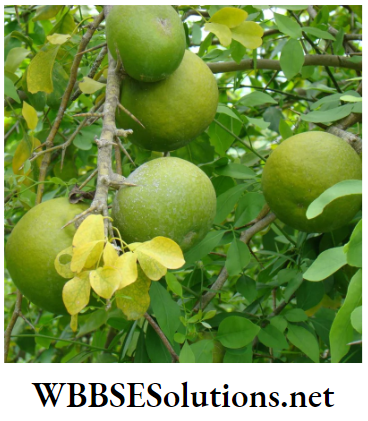
Medicinal use:
Bael fruit contains pectin and mucilage. The fruit is usually sliced and sun-dried. The hard leathery slices are then immersed in water.
They are prescribed for a number of diseases such as gastrointestinal diseases, piles, edema, jaundice, vomiting, obesity, pediatric disorders, gynecological disorders, urinary complaints, and as a rejuvenation.
Juice of Bael fruit is good for diarrhea patients. Unripe or partly ripe fruit increases appetite and digestive power. Bael leaves, fruit, and roots have antibiotic power.
Other Uses;
The fruit is eaten fresh or dried. If fresh, the juice is strained and sweetened to make a drink similar to lemonade. It can be made into sharbat (Hindi) or belpana, a refreshing drink made of pulp with water, sugar, and lime juice, mixed, left to stand for a few hours, strained, and put on ice.
One large bael fruit may yield five or six liters of sharbat.
The plant and its certain parts (leaves and fruits) are of religious importance since the tree is regarded as one of the sacred trees of Indian heritage.
Emblica (Amlaki)
Phyllanthus emblica, also known as emblic, amlaki, or amla from Sanskrit Amalia, is a deciduous tree. It is known for its edible fruit of the same name.
The tree is small to medium in size, reaching 8 to 18 m in height, with a crooked trunk and spreading branches. The branchlets are glabrous or finely pubescent, 10-20 cm long, and usually deciduous;
the leaves are simple, subsessile, and closely set along branchlets, light green, resembling pinnate leaves. The flowers are greenish-yellow.
The fruit is nearly spherical, light greenish yellow, quite smooth, and hard on appearance, with six vertical stripes or furrows.
Ripening in autumn, the berries are harvested by hand after climbing to the upper branches bearing the fruits. The taste of Indian gooseberry (amla) is sour, bitter, and astringent, and it is quite fibrous.
In India, it is common to eat gooseberries steeped in salt water and turmeric to make sour fruits palatable.
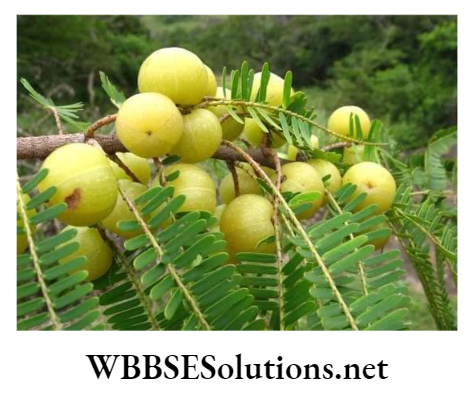
Medicinal use:
The nutritional facts of Amlaki include bioflavonoids, flavones, polyphenols, and carotenoids. It is the richest natural source of vitamin C available on this planet.
The unique thing about amlaki fruit is the ascorbic acid found is nearly indestructible even by burning or drying it. This makes the richest bio-availability of Vitamin C in this fruit which plays a significant role in the synthesis of neurotransmitters.
It is also required for collagen and carnitine synthesis, important molecules that produce energy from the fat cells whenever required.
- Health Benefits of Amlaki
- Amlaki inhibits the aging process and prevents the common cold.
- Amlaki is a nutritional powerhouse and is hence used to boost immunity and restore the body’s vitality.
- Amlaki provides energy to vital organs and is hence used in chronic illness recovery.
- Amlaki helps in regulating blood glucose levels in diabetic patients.
- Amlaki facilitates the absorption of iron in the body and improves hemoglobin levels. Amlaki possesses potent anti-inflammatory action and is hence used in various gastrointestinal tract inflammation such as gastritis.
- Amlaki contains natural digestive enzymes and is hence used in indigestion.
- Amlaki promotes spermatogenesis.
- Amlaki reduces serum cholesterol and high blood pressure.
- In Chinese traditional therapy, this fruit is used to treat throat inflammation.
Other use:
Popularly used in inks, shampoos, and hair oils, the high tannin content of Indian gooseberry fruit serves as a mordant for fixing dyes in fabrics.
Amla shampoos and hair oil are traditionally believed to nourish the hair and scalp and prevent premature grey hair.
Triphala: Literally meaning “three fruits”, Triphala is a traditional Ayurvedic herbal formulation consisting of three fruits native to the Indian subcontinent Amlaki (Emblica officinalis), Bibhitaki or Bahera (Terminalia bellirica) and Haritaki (Terminalia chebula).
Triphala is most commonly known for its use as a gentle bowel tonic, helpful in digestion and supporting regular bowel movements.
The combination of the three fruits has a synergistic effect to bolster many other systems as well. In addition to the Gl tract, Ayurveda uses Triphala to support healthy respiratory, cardiovascular, urinary, reproductive, and nervous systems.
Triphala has also been shown to be a powerful antioxidant, protecting cells from the damaging effects of free radicals
Nayantara
Nayantara (Catharanthus) Nayantara or Sadabahar or Periwinkle or Madagascar rosy periwinkle is an evergreen subshrub or herbaceous plant. This plant grows 1 m tall.
The leaves are oval to oblong, 2.5-9 cm long and 1-3.5 cm broad, glossy green, hairless, with a pale midrib and a short petiole 1-1.8 cm long; they are arranged in opposite pairs.
The flowers are white to dark pink with a darker red center, with a basal tube 2.5-3 cm long and a corolla 2-5 cm diameter with five petal-like lobes.
The fruit is a pair of follicles 2-4 cm long and 3 mm broad. In the wild, it is an endangered plant; the main cause of decline is habitat destruction by slash-and-burn agriculture.
It is also however widely cultivated and is naturalized in subtropical and tropical areas of the world.
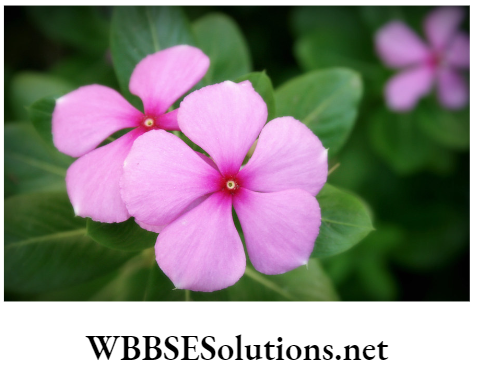
Medicinal Uses:
In traditional Chinese medicine, extracts from it have been used against numerous diseases, including diabetes, malaria, and Hodgkin’s lymphoma.
The leaf of Catharanthus is a good medicine for diabetes. The plant has dysentery and hemorrhage-resistant properties. The alkaloid Raubasine found in the root of the plant helps to remove obstacles in blood circulation.
Two other alkaloids called Vincristine and Vinblastine are found in the plant and are used to treat blood cancer and other types of cancers.
Its alkaloids are hypotensive, sedative and have tranquilizing properties, and are anti-cancerous. It helps in relieving muscle pain, depression of the central nervous system, and wasps stings.
Other Uses:
As an ornamental plant, it is appreciated for its hardiness in dry and nutritionally deficient conditions, popular in subtropical gardens where temperatures never fall below 5°C to 7°C, and as a warm-season bedding plant in temperate gardens.
It is noted for its long flowering period, throughout the year in tropical conditions, and from spring to late autumn, in warm temperate climates. Full sun and well-drained soil are preferred.
Mint (Pudina)
Mentha (also known as mint) is a genus of plants in the mint family. The species are not clearly distinct and estimates of the number of species vary from 13 to 18.
Hybridization between some of the species occurs naturally. Many other hybrids, as well as numerous cultivars, are known in cultivation.
While the species that make up the Mentha genus are widely distributed and can be found in many environments, most grow best in wet environments and moist soils.
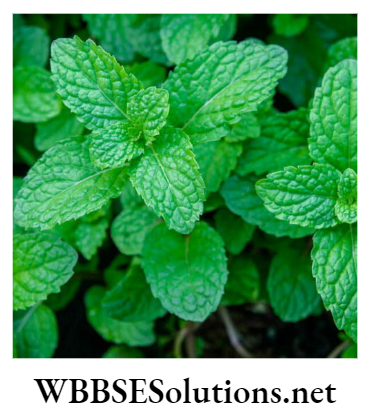
Mints will grow 10-120 cm tall and can spread over an indeterminate area. Due to their tendency to spread unchecked, some mints are considered invasive.
Mints are aromatic, almost exclusively perennial, rarely annual, herbs. They have wide-spreading underground and overground stolons and erect, square, branched stems.
The leaves are arranged in opposite pairs, from oblong to lanceolate, often downy, and with a serrated margin. Leaf colors range from dark green and gray-green to purple, blue, and sometimes pale yellow when dry they are usually dark green or green.
The flowers are white to purple and produced in false whorls called verticillasters. The corolla is two-lipped with four subequal lobes, the upper lobe usually the largest. The fruit is a nutlet, containing one to four seeds.]
Medicinal Uses:
- Pudina is used as a carminative and an expectorant.
- The plant is highly effective in treating headaches, rhinitis, cough sore throat, colic, and vomiting.
- It serves as a good blood cleanser since it is antiseptic and anti-bacterial.
- Pudina plays a significant role in alleviating swollen gums, mouth ulcers, and toothaches.
- Crushed and bruised pudina leaves are used in treating insect bites.
- The decoction and infusion of its leaves and stems help in fever, stomach aches, dysmenorrheal, and diuresis.
- Fresh leaves of pudina are crushed and sniffed for dizziness. Crushed leaves are also applied on the forehead and temple, to cure headaches.
- The menthol extracted from the plant is used in preparing balms.
Aloe Vera
Aloe vera (Ghritakumari) is a succulent plant species. The species is frequently cited as being used in herbal medicine since the beginning of the first century AD.
Extracts from Aloe vera are widely used in the cosmetics and alternative medicine industries, being marketed as variously having rejuvenating, healing, or soothing properties.
Aloe is one of the great healing agents among herbs. Indian aloe or Ghritkumari is a form of cactus. Aloes have long been in use for a host of diseases, particularly those connected with the digestive system and skin disorders.
it contains enzymes, polysaccharides, and nutrients that exhibit antibacterial and antifungal action. Aloe vera is useful in liver and spleen disorders, skin problems (scars, pimples, dermatitis, minor wounds or burns, etc.), external sores, hair problems, and eye troubles.
It is used as a flavoring agent in many culinary preparations.
Other Uses:
The leaf, fresh or dried, is the culinary source of mint. Fresh mint is usually preferred over dried mint when storage of the mint is not a problem.
The leaves have a warm, fresh, aromatic, sweet flavor with a cool aftertaste, and are used in teas, beverages, jellies, syrups, candies, and ice creams.
Mint essential oil and menthol are extensively used as flavorings in breath fresheners, drinks, antiseptic mouth rinses, toothpaste, chewing gum, desserts, and candies, such as mint (candy) and mint chocolate.
The substances that give the mints their characteristic aromas and flavors are menthol and pulegone. Mint was originally used as a medicinal herb to treat stomach aches and chest pains.
There are several uses in traditional medicine and preliminary research for possible use in treating irritable bowel syndrome.
Menthol from the mint essential oil (40-90%) is an ingredient of many cosmetics and some perfumes. Menthol and mint essential oil are also used in aromatherapy which may have clinical use to alleviate post-surgery nausea.
Mint oil is also used as an environmentally friendly insecticide for its ability to kill some common pests such as wasps, hornets, ants, and cockroaches, and has small white teeth.
The flowers are produced in summer on a spike up to 90 cm (35 in) tall, each flower being pendulous, with a yellow tubular corolla 2-3 cm (0.8-1.2 in) long.
Medicinal Uses:
Aloe vera is used in traditional medicine as a multipurpose skin treatment. Aloe vera is used on facial tissues where it is promoted as a moisturizer and anti-irritant to reduce chafing of the nose.
Cosmetic companies commonly add sap or other derivatives from Aloe vera to products such as makeup, tissues, moisturizers, soaps, sunscreens, incense, shaving cream, or shampoos.
Aloe vera gel is effective in treating psoriasis, seborrhea, dandruff, minor burns, and skin abrasions, as well as radiation-induced skin injuries.
Aloe vera juice (also called latex) taken by mouth is a powerful laxative. Aloe vera gel taken orally (by mouth) seems to help people with diabetes by lowering blood sugar levels.
It may also help to lower cholesterol. Extracts of aloe vera leave contain vitamins, minerals, amino acids, and fatty acids.
It is used to reduce acidity, and inflammation of bone joints, and to reduce fever (antipyretic to reduce mental stress and tension.
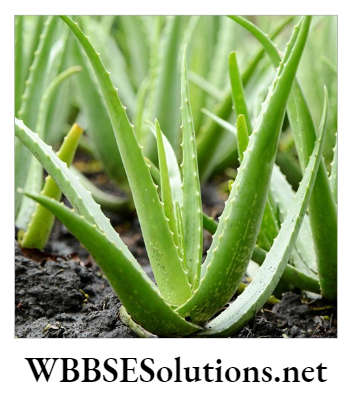
In-depth explanations of environmental issues for Class 8
Question 9. Write the uses of Neem.
Answer:
Neem:
Neem (Azadirachta indica), is a tree in the mahogany family. It is one of two species in the genus Azadirachta and is native to India and the Indian subcontinent including Nepal, Pakistan, Bangladesh, and Sri Lanka.

Neem is a fast-growing tree that can reach a height of 15-20 meters (49-66 ft), rarely 35-40 meters (115— 131 ft). It is evergreen, but in severe drought, it may shed most or nearly all of its leaves.
The branches are wide and spreading. The fairly dense crown is roundish and may reach a diameter of 15-20 meters (49-66 ft) in old, freestanding specimens.
General uses:
- Neem leaves are dried in India and placed in cupboards to prevent insects from eating the clothes and also while storing rice in tins.
- Neem leaves are dried and burnt in tropical regions to keep away mosquitoes as Ayurveda herb. Neem is also used in baths.
- Neem contains chemicals that might help reduce blood sugar levels, heal ulcers in the digestive tract, prevent conception, kill bacteria, and prevent plaque formation in the mouth.
- The tender shoots and flowers of the neem tree are eaten as a vegetable in India. In West Bengal, young neem leaves are fried in oil with tiny pieces of eggplant (brinjal).
- The dish is called nim begun and is the first item during a Bengali meal that acts as an appetizer. It is eaten with rice
Medicinal property: Neem products are believed to be anthelmintic, antifungal, antidiabetic, antibacterial, antiviral, contraceptive, and sedative.
Neem oil Is used for pain in the ear, gum, and tooth. Neem seed is used in viral epidemics and arthritis. The bitter tasted tonic made from the bark of the root and stem is useful in breaking periodic sequences of fevers (like malaria).
Neem oil is used for healthy hair, to improve liver function, detoxify the blood, and balance blood sugar levels. Neem leaves have been used to treat skin diseases like eczema, psoriasis, etc. The juice of neem leaves is useful for diabetes.
Other uses
Toiletries: Neem oil is used for preparing cosmetics such as soap, shampoo, balms, and creams as well as toothpaste.
Toothbrush: Traditionally, slender neem twigs (called datum are first chewed as a toothbrush and then split as a tongue cleaner.
Tree: Besides its use in traditional Indian medicine, the neem tree is of great importance for its anti-desertification properties and possibly as a good carbon dioxide sink.
Cosmetics: Neem is perceived in India as a beauty aid. Powdered leaves are a major component of at least one widely used facial cream. Purified neem oil is also used in nail polish and other cosmetics.
Bird repellent: Neem leaf boiled in water can be used as a very cost-effective bird repellent, especially for sparrows.
Lubricant: Neem oil is non-drying and it resists degradation better than most vegetable oils. In rural India, it is commonly used to grease cart wheels.
Fertilizer: Neem has demonstrated considerable potential as a fertilizer. Neem cake is widely used to fertilize cash crops, particularly sugarcane and vegetables.
Honey: In parts of Asia neem honey commands premium prices, and people promote apiculture by planting neem trees.
Soap: 80% of India’s supply of neem oil is now used by neem oil soap manufacturers. Additionally, it is antibacterial and antifungal, soothing, and moisturizing. It can be made with up to 40% neem oil.
Against pox viruses: In Tamilnadu, people who are affected by pox viruses are generally made to lie in a bed made of neem leaves and branches. This prevents the spreading of pox virus to others and has been in practice since the early centuries.
WBBSE Class 8 Science practice long answer questions on biodiversity
Question 10. Describe the uses of Bael and Amlaki.
Answer:
Bael:
Aegle marmelos, commonly known as bael, Bengal quince, golden apple, stone apple, and wood apple, is a species of tree native to India.
It is present throughout Southeast Asia as a naturalized species. The tree is considered to be sacred by Hindus. Its fruits are used in traditional medicine and as a food throughout its range.
The bael fruit has a smooth, woody shell with a green, gray, or yellow peel. It takes about 11 months to ripen on the tree and can reach the size of a large grapefruit or pomelo, and some are even larger.
The shell is so hard it must be cracked with a hammer or machete. The fibrous yellow pulp is very aromatic. It has been described as tasting of marmalade and smelling of roses. Numerous hairy seeds are encapsulated in slimy mucilage.

Medicinal use:
Bael fruit contains pectin and mucilage. The fruit is usually sliced and sun-dried. The hard leathery slices are then immersed in water.
They are prescribed for a number of diseases such as gastrointestinal diseases, piles, edema, jaundice, vomiting, obesity, pediatric disorders, gynecological disorders, urinary complaints, and as a rejuvenation.
Juice of Bael fruit is good for diarrhea patients. Unripe or partly ripe fruit increases appetite and digestive power. Bael leaves, fruit, and roots have antibiotic power.
Other Uses;
The fruit is eaten fresh or dried. If fresh, the juice is strained and sweetened to make a drink similar to lemonade. It can be made into sharbat (Hindi) or belpana, a refreshing drink made of pulp with water, sugar, and lime juice, mixed, left to stand for a few hours, strained, and put on ice.
One large bael fruit may yield five or six liters of sharbat.
The plant and its certain parts (leaves and fruits) are of religious importance since the tree is regarded as one of the sacred trees of Indian heritage.
Emblica (Amlaki)
Phyllanthus emblica, also known as emblic, amlaki, or amla from Sanskrit Amalia, is a deciduous tree. It is known for its edible fruit of the same name.
The tree is small to medium in size, reaching 8 to 18 m in height, with a crooked trunk and spreading branches. The branchlets are glabrous or finely pubescent, 10-20 cm long, and usually deciduous;
the leaves are simple, subsessile, and closely set along branchlets, light green, resembling pinnate leaves. The flowers are greenish-yellow.
The fruit is nearly spherical, light greenish yellow, quite smooth, and hard on appearance, with six vertical stripes or furrows.
Ripening in autumn, the berries are harvested by hand after climbing to the upper branches bearing the fruits. The taste of Indian gooseberry (amla) is sour, bitter, and astringent, and it is quite fibrous.
In India, it is common to eat gooseberries steeped in salt water and turmeric to make sour fruits palatable.

Medicinal use:
The nutritional facts of Amlaki include bioflavonoids, flavones, polyphenols, and carotenoids. It is the richest natural source of vitamin C available on this planet.
The unique thing about amlaki fruit is the ascorbic acid found is nearly indestructible even by burning or drying it. This makes the richest bio-availability of Vitamin C in this fruit which plays a significant role in the synthesis of neurotransmitters.
It is also required for collagen and carnitine synthesis, important molecules that produce energy from the fat cells whenever required.
- Health Benefits of Amlaki
- Amlaki inhibits the aging process and prevents the common cold.
- Amlaki is a nutritional powerhouse and is hence used to boost immunity and restore the body’s vitality.
- Amlaki provides energy to vital organs and is hence used in chronic illness recovery.
- Amlaki helps in regulating blood glucose levels in diabetic patients.
- Amlaki facilitates the absorption of iron in the body and improves hemoglobin levels. Amlaki possesses potent anti-inflammatory action and is hence used in various gastrointestinal tract inflammation such as gastritis.
- Amlaki contains natural digestive enzymes and is hence used in indigestion.
- Amlaki promotes spermatogenesis.
- Amlaki reduces serum cholesterol and high blood pressure.
- In Chinese traditional therapy, this fruit is used to treat throat inflammation.
Other use:
Popularly used in inks, shampoos, and hair oils, the high tannin content of Indian gooseberry fruit serves as a mordant for fixing dyes in fabrics.
Amla shampoos and hair oil are traditionally believed to nourish the hair and scalp and prevent premature grey hair.
Question 11. Write about one medicinal use of Triphala. What is piperine?
Answer:
Triphala:
Literally meaning “three fruits”, Triphala is a traditional Ayurvedic herbal formulation consisting of three fruits native to the Indian subcontinent Amlaki (Emblica officinalis), Bibhitaki or Bahera (Terminalia bellirica) and Haritaki (Terminalia chebula).
Triphala is most commonly known for its use as a gentle bowel tonic, helpful in digestion and supporting regular bowel movements.
The combination of the three fruits has a synergistic effect to bolster many other systems as well. In addition to the Gl tract, Ayurveda uses Triphala to support healthy respiratory, cardiovascular, urinary, reproductive, and nervous systems.
Triphala has also been shown to be a powerful antioxidant, protecting cells from the damaging effects of free radicals
ried ground pepper has been used since antiquity for both its flavor and as a traditional medicine. Black pepper is the world’s most traded spice.
It is one of the most common spices added to European cuisine and its descendants. The spiciness of black pepper is due to the chemical piperine. It is ubiquitous in the modern world as a seasoning and is often paired with salt.
Apart from spicy value, black pepper is also used as a preservative for meat and other perishable food items.
The health benefits of black pepper include relief from respiratory disorders, coughs, the common cold, constipation, indigestion, anemia, impotency, muscular strains, dental disease, pyorrhea, diarrhea, and heart disease.
Black pepper (Piper nigrum)stimulates the taste buds in such a way that an alert is sent to the stomach to increase hydrochloric acid secretion, thereby improving digestion.
Hydrochloric acid is necessary for the digestion of proteins and other food components in the stomach. Black pepper has long been recognized as a carminative,
(a substance that helps prevent the formation of intestinal gas), a property likely due to its beneficial effect of stimulating hydrochloric acid production.
In addition, black pepper has diaphoretic (promotes sweating), and diuretic (promotes urination) properties.
Question 12. Name the plants from which the following compounds are obtained :
- piperine
- curcumin
- allicin
- Raubasine
- antipyretic compound
- Vinblastine
Answer:
- Black pepper
- Turmeric
- Garlic
- Catharanthus
- Aloe vera
- Catharanthus

